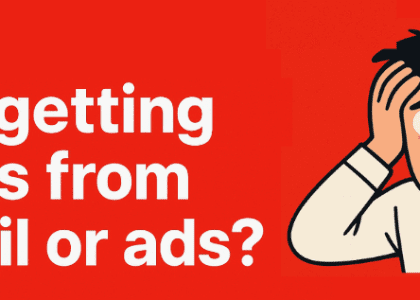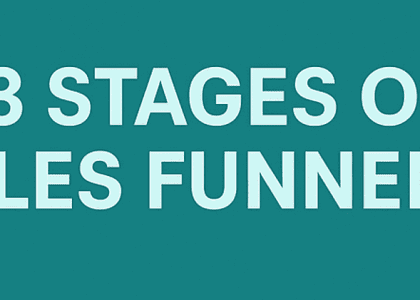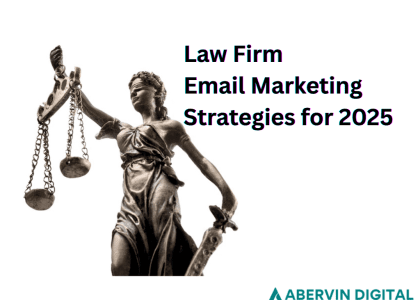Want to 10X Your ROI with Ecommerce Email Segmentation?
Short answer: Hire Abervin Digital – your go-to Ecommerce email marketing agency.
Yes, this is a promo blog. But it’s packed with the exact strategies we use for top-performing brands. You can copy these ideas, set them up yourself, and watch your results climb. That said, let’s get into it!
If you’re like most e-commerce brands, you’re already collecting subscriber data. But data alone doesn’t grow revenue. In fact, we break this down fully in our complete 2025 ecommerce email marketing guide, including how to use that data to drive sales and scale sustainably.
It’s what you do with that data that determines whether you build a profitable relationship with your audience or become another brand they unsubscribe from without blinking.
Why Segmentation Beats “Spray and Pray” Emails
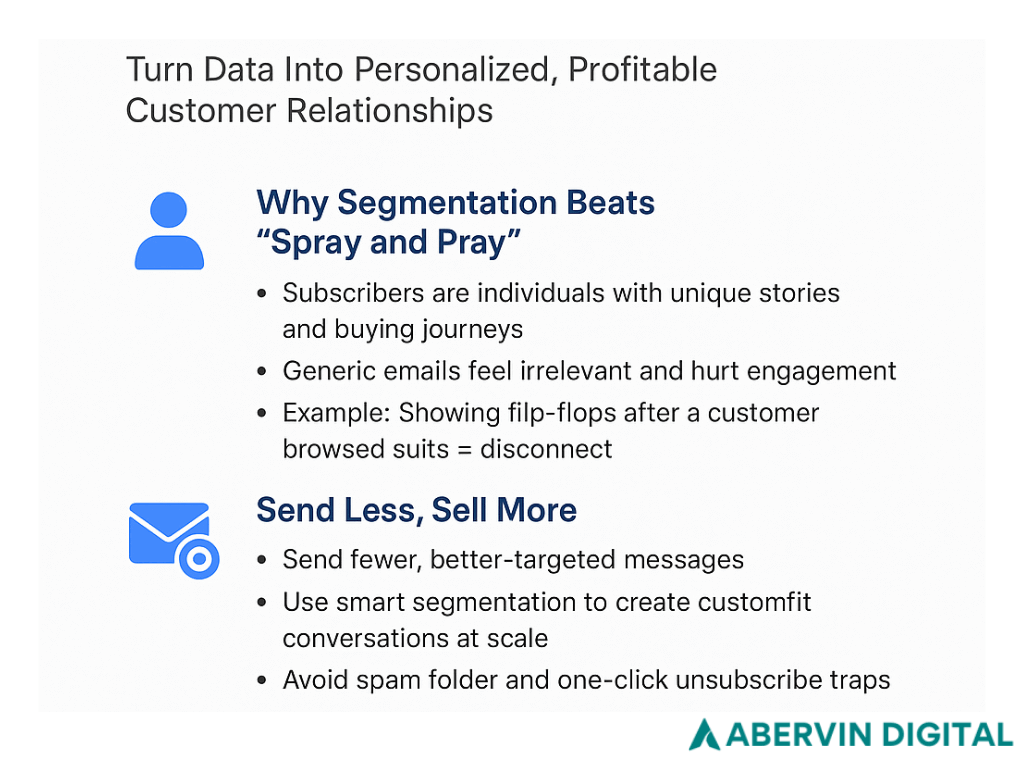
When you’re analyzing your subscriber data, it’s easy to fixate on vanity metrics like open rates, click-throughs, list size. But the truth is every subscriber is a living, breathing person with a story, a mood, and a unique buying journey.
When you treat them as data points rather than human beings, your emails fall flat. But when you personalize every message, when your communication feels custom-fit to their needs, their behaviors, and their mindset, that’s when the magic happens.
Not segmenting your audience is kinda like this: Let’s say you just browsed a three-piece suit the night before and the next morning you get a promo for flip-flops, what message does that send? That your time and attention don’t matter to whoever sent that email to you.
And that’s the kind of disconnect Gmail’s new one-click unsubscribe is designed for.
Send Less, Sell More With Smart Segmentation
To stay welcome in the inbox, you have to send fewer, better messages – the ones that hit because they’re relevant. That’s where ecommerce email segmentation transforms generic blasts into custom-fit conversations at scale.
If you’re not sure where to start or which platform gives you the tools to segment effectively, we’ve broken it all down in our complete guide to choosing the best email marketing software. It covers everything from automation features to ease of use so you can pick a solution that fits your goals and your audience.
Segmentation isn’t just a marketing tactic, it’s customer respect in action – and at Abervin Digital, we’ve mastered how to use it not just to keep your list happy, but to unlock buried revenue sitting inside your own data. Let’s get into it.
4 Core Ecommerce Email Segmentation Strategies for Your Online Store
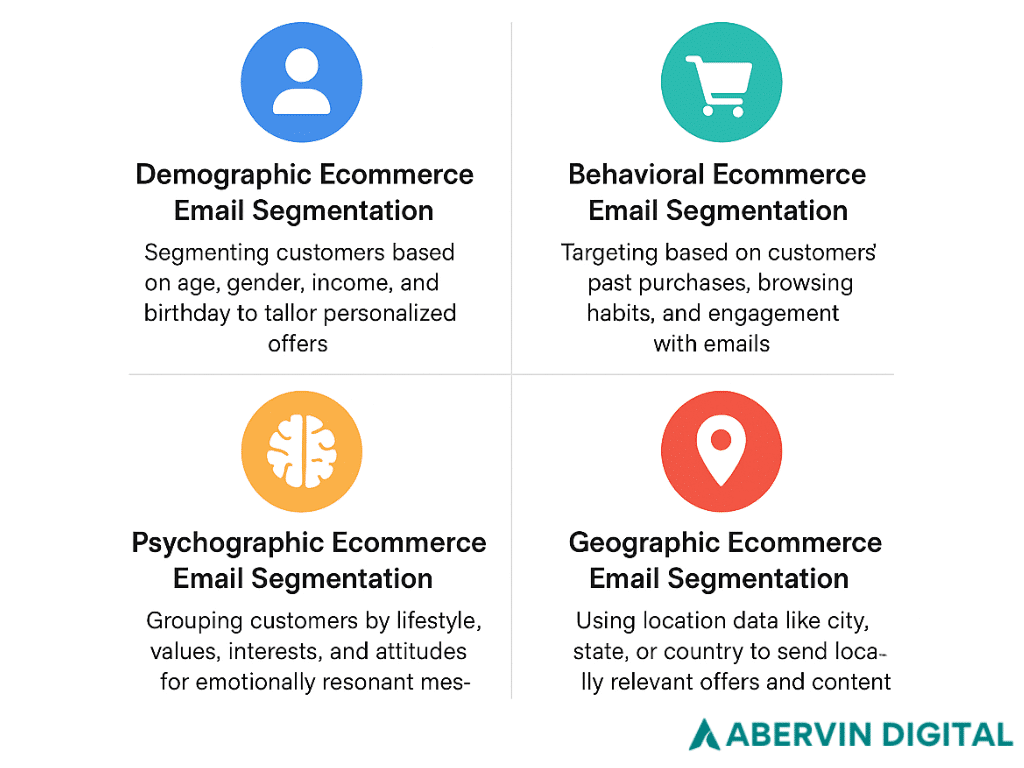
Ecommerce email segmentation isn’t one-size-fits-all. That’s why getting it right is a science. More importantly, getting it wrong costs you money. Too often, brands settle for generic segments like “engaged” or “past buyer” and call it a day. That’s just scratching the surface. If you want real ROI, you need ecommerce email segmentation that treats your audience not as “lists” but as a community full of potential.
At Abervin Digital, an expert Ecommerce email marketing agency, we break segmentation down into 4 high-impact methods. Each one helps you connect with your customers’ emotional triggers, buying signals, and real-life context. These segments don’t just get more opens and clicks; they lead to repeat purchases, increased LTV, and make your email marketing feel like a personal message not brand blasts.
Let’s get into how we use each one to turn inboxes into income.
Demographic Ecommerce Email Segmentation (Beyond Age & Gender)
If you’re an experienced email marketer, it’s easy to dismiss demographic segmentation as a relic from the Mad Men era where marketers made assumptions based on age, gender, or zip code.
But in 2025, Ecommerce email segmentation still works because a 23-year-old female gym rat in Brooklyn and a 23-year-old female gamer in Austin live in entirely different realities – and if your email speaks to both the same way, you’ll end up speaking to none of ’em.
At Abervin, we don’t treat demographics as boxes to sort people into. We treat them as entry points into deeper content customization. So what we do is we pair raw traits (age, income, gender identity, family structure) with behavior, cultural influence, and aesthetic preference so our targeting is more laser-focused. We don’t just segment a skincare audience into “Millennials” and “Boomers”, we build variant personas like:
- The Sweat-Proof Serotonin Chaser (Gen Z gym lovers)
- The Stress-Aging Executive Mom (late-40s C-suite, skincare as self-care)
- The Minimalist Dad Who Steals Her Serum (mid-30s, dual-income urbanites)
And we write specifically for each. We had a client in the skincare niche who wanted to push a retinol-based night serum. Instead of one generic email blast, we created two highly specific campaigns:
- One for fitness-obsessed Gen Z women with copy like: “Night shift? Let this serum do the heavy lifting while you recover from leg day.”
- Another for high-earning Gen X women focused on aging gracefully: “For the woman who handles boardrooms by day – and collagen loss by night.”
Same product. Two radically different messages. Both converted because we used advanced ecommerce email segmentation – the kind of strategy you want from a dedicated ecommerce email marketing agency.
Behavioral Ecommerce Email Segmentation
Clicks, scrolls, abandoned carts are behavioral cues and ignoring them in 2025 is like having someone wave money at your store window and you locking the door.
What most brands get wrong is they collect behavior but don’t react to it. For our clients at Abervin, we get ahead of that by building dynamic engagement maps that update per user action across channels. Unlike other segmentation methods where the list is usually static, the profiles we collect based on behavioral segmentation change every time someone clicks, swipes, or bounces.
We don’t just track that a user clicked on “red heels.” We track how many times, on what days, after what emails, and before what drop-off point. And based on that, we build behavior-triggered automations that speak directly to their interest.
So to put that into perspective, let’s say a customer viewed red heels three times in five days but didn’t purchase.
We’ll deploy a sequence like this:
- Email 1: Show the same heels styled by real customers on Instagram with a glowing review.
- Email 2 (24 hours later): Notify them that there are only 6 pairs left in their size.
- Bonus SMS (only for VIP list): Offer a 15% discount if they click within 3 hours.
When you see our clients’ glowing results, it’s this kind of behavioral ecommerce email segmentation that turns browsers into buyers and buyers into loyal fans who feel genuinely seen. Happy customers, happy clients, happy us!
Psychographic Ecommerce Email Segmentation
Why do some people sip black coffee from a chipped mug while others won’t touch anything but an oat milk latte in a $70 Stanley tumbler? It’s not just about caffeine but about their identity. And that’s exactly why ecommerce email segmentation is a game changer. We don’t just want to know who your customers are on paper, we want to understand why they make the choices they do.
At Abervin, we go beyond demographics by diving into psychographics, your customers’ values, habits, preferences, and aspirations. This insight lets us craft emails that feel less like ads and more like conversations with a smart marketing friend who really gets them.
We uncover this through:
- Short-form quizzes and micro-surveys
- Scroll-depth heatmaps to gauge where they linger
- Social listening across Reddit, Discord, and niche Facebook groups
From there, we build emotional positioning into campaigns that speak to them like we really know them in real life. Let’s say you sell backpacks. You could just say “durable & waterproof.” Everyone says that right?
But if you know your audience is made up of digital nomads obsessed with minimalism and climate action, your pitch shifts completely.
Our messaging becomes: “Built for carry-on-only travelers who hate clutter and love impact. Made with 100% recycled fabric. Zero plastic fillers. Just sleek, storm-proof function you’ll carry for years.”
This approach isn’t about features but about identity. When your ecommerce email segmentation mirrors your buyer’s values, your emails don’t push, they pull. That’s how real connections and conversions happen.
Geographic Ecommerce Email Segmentation
Back in the day… geolocation used to mean, “We ship to your state.” Now it means, “We understand your weather, your holidays, your mindset.”. It might sound a little invasive, but at Abervin, we treat ecommerce email segmentation as a cultural and seasonal alignment game-changer. We create emails that speak your customer’s language… the stuff that really matters day to day. Because no matter how awesome your product is, if you frame it wrong, it’s gonna flop.
Imagine sending a “Cozy Flannel Sale” to Florida in June, you’re not just pissing people off, you’re losing trust and clicks. What we would do for your brand is we build geo-aware flows that factor in:
- Time zone-triggered send windows
- Weather APIs for real-time promo relevance
- Localized copy that name-drops events, landmarks, or slang
And if you were running a sale on jackets, the lazy way would be to just go “Get 20% Off All Outerwear This Week Only!” but an expert from Abervin can use geo-personalized targeting for:
- New York Customers:
Subject: “Snow’s Coming, NYC ❄️ Your Winter Sale Starts Now”
Body: “From Brooklyn to the Bronx, layer up with 20% off cold-weather gear.” - Miami Customers:
Subject: “Light Layers for Late Nights 🌴”
Body: “When 72 degrees is ‘chilly’ – these breathable jackets are made for Magic City.”
So when both New Yorkers and folks in Miami receive an email with this level of geographic empathy, it doesn’t just improve your CTR, it also shows your audience you understand their world. And that builds trust and that’s the ultimate conversion engine.
How Ecommerce Email Segmentation Powers Smarter Campaigns
These geographic tactics are just one slice of the segmentation pie. At Abervin, we use four core segmentation types: Demographic, Behavioral, Psychographic, and Lifecycle but it’s how we apply them that’s different. Using these strategies, our clients have seen 2-10X revenue growth, without spamming anyone with irrelevant emails.
So, how do you actually apply this? We’ve helped brands roll out ecommerce email sequences using 10 proven segmentation methods that drive loyalty and repeat sales. Below, we’ll break down these strategies and tie them back to those core segmentation types.
But before we jump in, if you’re not sure if you should be using email marketing for your brand, our blog on Email Marketing for eCommerce in 2025: 8 Benefits For Brands has all you need to help you make the right choice for your business.
Want 10X Sales? Start With Ecommerce Email Segmentation That Works
Ecommerce email segmentation is the secret sauce to turning your email list into a high-converting sales machine
Whether you’re nurturing newcomers, reactivating past buyers, or creating offers to match your customer’s preferences and behavior, these examples will show you exactly how to segment smarter and grow your small business faster with email marketing in 2025.
Too busy to do it yourself? Then consider hiring an email marketer to build it out and get results faster
7 MUST-HAVE Behavioral Segments To 10X Your Sales
When it comes to making your emails feel personal and perform like clockwork, behavioral segmentation is your best friend. Why? Because it focuses on what your customers actually do… not just who they are or what they say they like. It’s all about how they interact with your brand in real time.
Here are seven powerful behavioral segments that help craft an ecommerce email sequence your subscribers can’t resist opening, clicking, and converting on.
1. Customer Engagement
Engaged customers are your hottest audience. They’re opening your emails, clicking through, and maybe even browsing your site. Segment these folks based on recent activity say, within the last 30, 60, or 120 days, and create your messaging to reward their attention. Maybe it’s early access to sales, sneak peeks of new products, or just a simple “Hey, thanks for sticking with us.”
Engagement isn’t static so you’ll need to keep watching it. As someone stops opening, shift them to a win-back flow. When someone starts clicking more often, bump them up to your VIP list.
2. Past Purchase History
Nothing predicts a customer’s next move like their last one. Ecommerce email segmentation by past purchase history means grouping customers based on what they’ve bought, how often, and how recently. This lets you:
- Send smart replenishment emails (“Running low on those vitamins?”)
- Upsell related products (“If you liked that candle, you might love this diffuser”)
- Avoid sending irrelevant promos (why pitch socks to someone who only buys sandals?)
Look for patterns. Are they a one-and-done buyer, or do they have a subscription vibe? Let their behavior guide your pitch.
3. Customer Reviews
Customer reviews serve double duty in your ecommerce email segmentation strategy. They’re a behavioral signal. A review means someone took time to share their experience and that alone deserves recognition. When you get positive reviewers, send them a thank-you and a referral code and if there are negative reviewers, show empathy and send a personal follow-up or offer help. These moments can turn haters into loyal fans.
Plus, reviews can hint at preferences, making them a gateway to psychographic segmentation too. Someone who raves about your eco-packaging clearly cares about sustainability.
4. Purchase Amounts
Not all buyers have the same deep pockets. It’s like George Orwell’s Animal Kingdom and so some buyers spend $15, others $500. So you want to segment based on AOV (Average Order Value) or specific spend thresholds.
- For High spenders, you can offer loyalty perks, exclusive drops, and concierge-like service.
- For low spenders, you can send value-based messaging, bundles, or first-time buyer nudges.
You can even use this to test discount sensitivity. A high spender who only buys during sales might need a different incentive than a full-price buyer.
5. Acquisition Source
Where a customer comes from tells you what they value. Did they arrive via referral, influencer, or Facebook ad? Ecommerce email segmentation based on acquisition source helps you speak their language.
- If they came from a referral, thank them and offer a “share with a friend” discount.
- If they came from social media, using informal tone, highlight visuals and slangs will help you get closer to their hearts.
- For those who found you via organic search, you can lead with education or trust-building content.
This is especially useful in your welcome flows, where first impressions really count.
6. Last Viewed Products
There are always those that viewed but didn’t buy – that action still shows intent. This behavior lets you segment these customers based on their browsing history and follow up with reminders, reviews, or social proof.
Instead of one-size-fits-all browse abandonment emails, you can send emails that sound a lot more personal:. Something like “Still thinking about that linen shirt? It’s one of our bestsellers.”
7. Abandoned Cart Value
Abandoned cart emails are great but if you want to take your ROI to the next level, you need segmented abandoned cart emails. To do that, simply split your abandoned cart flows based on cart value. You can have conditions and content like:
- Carts under $50: Remind gently. No discount needed.
- Carts $50-$200: Add urgency or low-stock alerts.
- Carts over $200: Consider adding a time-limited offer or even personalized outreach.
The goal isn’t just recovery, we also want to improve our margins and build trust.
2 MUST-HAVE Psychographic Segments To 10X Your Sales
If behavioral data tells you what a customer does, then psychographics tell you why they do it – their values, motivations, beliefs, and preferences. When we market to someone based on their psychographic analysis, we tap into what makes them tick on a personal level.
With the right tools (like surveys, quizzes, and review analysis), you can start segmenting psychographically today.
1. Customer Preferences (via quizzes/surveys)
Ever taken a product quiz and thought, “Wow, this brand gets me”? That’s the power of preference-based segmentation.
Quizzes and surveys are goldmines for psychographic data. Whether you’re asking about skincare goals, home decor styles, or wellness priorities, each answer helps build a customer profile that goes beyond demographics.
Here’s how to use it:
- Email product recommendations that match their quiz results.
- Create dynamic flows based on style, values, or routines they report in surveys.
- Speak their language, match their tone and priorities in your messaging.
Understanding customer preferences lets you know not just what to send but also what not to send. For example, a customer who says they prioritize sustainability doesn’t just want a 20% off code, they want to know how your product reduces waste. One who picks “minimalist aesthetic” isn’t interested in your neon summer collection. The key is to treat preferences not as signals for how to personalize every touchpoint.
2. Customer Reviews (can double as psychographic signals)
Earlier we said reviews are a behavioral signal but they’re also a gateway to psychographic segmentation too. Reviews don’t just reflect satisfaction, they reflect identity. Let’s say a customer leaves a glowing review about your eco-friendly packaging. That tells you they care about sustainability. If another customer raves about how fast your product worked, now you know they’re results-driven and value speed.
Here’s how to you can use reviews psychographically:
- Look through reviews to spot patterns in words and values. Use simple tools or even read them manually to spot what customers care about.
- Tag and segment customers based on what matters to them: things like performance, ethics, status, or comfort.
- Trigger personalized flows – For example, if someone mentioned loving your cruelty-free promise, they might be excited to hear about your newest vegan product.
What’s powerful about reviews is that customers are telling you, in their own words, what they care about. You don’t have to guess and when you use those words in your follow-up messaging, you stop sounding like a marketer and start sounding like a brand that actually listens.
ONE MUST-HAVE Demographic Segment To 10X Your Sales
People hear demographic and it just feels basic like, “Wow, thanks for telling me my customer is a 28-year-old female from Atlanta… groundbreaking.” But the truth is that’s a lot of information right there because when used surgically, even a “simple” data point like a birthday becomes a revenue event. A loyalty booster moment where your brand becomes unexpectedly thoughtful.
Think about it.
On your birthday, you’re quietly expecting a little magic – even if you don’t care for it. If someone gave you a free cup of coffee, a surprise discount to buy something you love… if a brand you love remembers you, you’ll feel just a little better.
When done well, birthday emails aka demographic segmentation emails aren’t marketing…they’re emotional marketing. They work because they tap into identity and perfect timing and there’s no better marketing combo.
What to Send (and Why It Works)
You don’t need to reinvent the wheel here. Some of the highest-performing birthday emails we’ve helped build contain just three ingredients:
- A clean subject line with the word “Birthday” in it: Yes, it’s that simple. “It’s your birthday 🎉 We got you something” has killer open rates.
- A generous (but strategic) offer. Something like 20% off, free shipping, gift with purchase, or double loyalty points. You can let it run for 5–7 days to build urgency without seeming pushy.
- A design that feels personal. You can use their name, throw in a confetti GIF or emoji – just make sure you’re using emojis the right way in your subject lines to boost opens without triggering spam filters. That way, it feels more like a celebration than a conversion push..
Something we’ve found most brands miss about the birthday email is it isn’t just a one-off campaign, it’s a gateway to deeper segmentation. If someone redeems your birthday offer, that’s a buying signal – and if they don’t, that’s a chance to run a winback. You’re not just sending confetti. You’re collecting intent.
If you’re setting this up right now, then don’t forget to schedule the birthday flow to trigger 3–5 days in advance so customers have time to act. Also, for this to work, you’ll need to collect birthday data at opt-in with a single field (month + day is enough). This way you can plug this data into subject lines and CTA.
And that’s a wrap on learning about how advanced segmentation can skyrocket your e-commerce ROI.
If you’ve made it this far, it means you’re not just here to send a bunch of emails, you’re here to build real connections with your customers. You want to treat them like people, not just names on a list.
In 2025, smart brands don’t see email as just another marketing tool. They see it as a powerful way to build a community, keep customers coming back, and grow their sales long-term.
So don’t let what you’ve just read stay as another tab on your screen. Pick one thing you learned today and put it into action. Build a welcome series. Fix that abandoned cart email. Segment your list so you’re talking to real people, not just blasting everyone the same message.
These advanced segmentation strategies are a key part of effective email list management. We dive deeper into this in our blog: 4 Tips for Effective Email List Management.
And if you need help turning all of this into a winning strategy… we’re here.
At Abervin Digital, we help e-commerce brands grow with smart, personalized email marketing that works even when your ads are on pause. Whether you need better flows, list clean-ups, or a complete email strategy that drives results, we’ve got your back.
Contact us at +1 (720) 583-5547 or visit abervindigital.com to see how we can help. Let’s build emails that get opened, clicked, and bring real money in.



